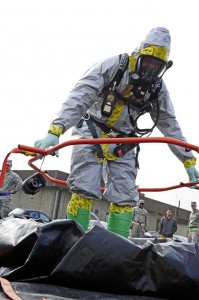Whether in a person’s workplace or in response to an emergency, the 86th Aerospace Medicine Squadron bioenvironmental engineering flight is there to ensure the safety of Airmen executing their mission by identifying and eliminating threats in the workplace.
The performance of health-risk assessments brings noise, air quality, chemical exposure, radiation and other potential safety concerns to light by measuring them in the Airmen’s working environment.

Airman 1st Class Eric Roberts, 86th Aerospace Medical Squadron bioenvironmental engineer journeyman, goes through decontamination after leaving a crime scene during a biological response exercise on Ramstein. The squadrons train quarterly to stay prepared for real-world situations.
Measurements are taken in various ways, such as taking water samples, attaching devices to Airmen in their work environment to check the sound levels to which they are exposed, testing the air quality to ensure proper ventilation keeps a healthy level of oxygen in the air, and inspecting any personal protective equipment to confirm it is able to act as a barrier between Airmen and potential hazards.
Through the assessments, the processes performed by each of these workplaces are reviewed. The various chemicals the unit may come into contact with or could be potentially exposed to are evaluated, and anything considered high risk is brought to the attention of the unit to be corrected. Follow-up assessments are performed every month by a surveillance team.
“The main purpose of our job is to characterize all the workplace exposures,” said Capt. Rogelio Rodriguez, 86th AMDS bioenvironmental engineering flight occupational health OIC. “What is the main thing that BEE is known for? Gas mask fit tests, which is important, but there is so much more that we do on the base for all of the Airmen as a whole than just gas mask fit tests.”
One of the services the bioenvironmental engineering flight offers as a way for units to mitigate any potential mishaps is training. This allows Airmen who work with hazardous materials to reduce adverse health effects caused by over-exposure.
“We aren’t necessarily inspectors and we aren’t here just to write people up,” Rodriguez said. “We are here to help workplaces stay safe.”
The bioenvironmental engineering flight takes calls regarding indoor air quality concerns, suspicious packages and gas mask fit test hours to support service members.
Rodriguez said the mission is bigger here compared to most bases. The 86th AMDS bioenvironmental engineering flight supports not only Ramstein, but also Landstuhl Regional Medical Center, Vogelweh, Morón Air Base, Spain, and Chievres Air Base, Belgium.
“What we do involves taking care of anyone who works in the areas we cover,” said Staff Sgt. Jennifer Kotz, 86th AMDS bioenvironmental engineering flight readiness and training NCOIC. “If they are not healthy, then they can’t get the mission done.”
Ramstein and installations covered by the 86th AMDS are able to perform their duties with reduced risk of health issues when their buildings and work areas are safe. The bioenvironmental flight’s ability to detect risky conditions guarantees aircraft get off the ground because the Airmen working on them, the pilots flying them and everyone
else involved work in a safe environment.


